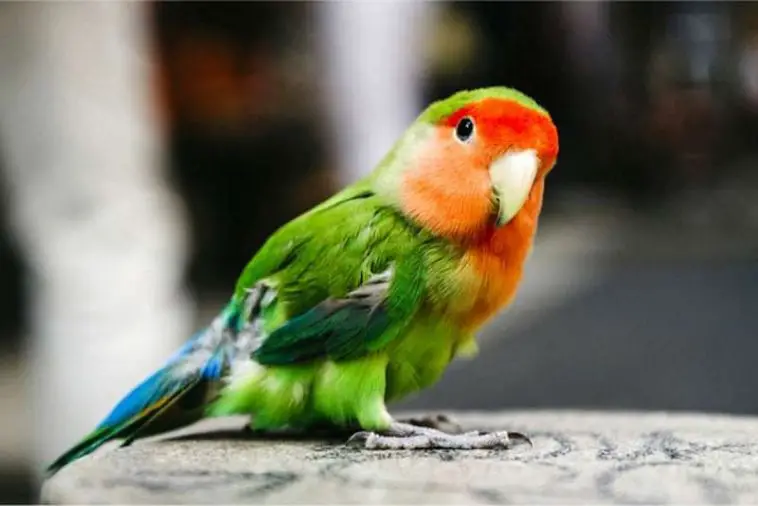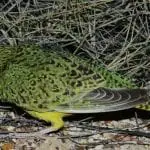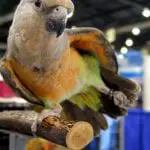Scientific Facts
| Common Name | Peach-face Lovebird, Peach-faced Lovebird, and Rosy-faced Lovebird |
| Scientific Name | Agapornis roseicollis |
| Size | up to 7 inches |
| Life Span | 10-15 years |
| Habitat | Found up to 1500min dry wooded areas, also sub desert steppe, savanna woodland with sparse tree cover, woodland belts along rivers, and cultivated land. |
| Country of Origin | Namibia, Angola |
It was reported, in 1818, by the French ornithologist Louis Jean Pierre Vieillot. Later transferred to the genus Agapornis alongside the different lovebirds, though it was formerly termed Psittacus roseicollis.
The famous peach-faced lovebird radiates a huge character in a little frame. Peach faces adore their leisure and assertive synergy with their humans. A peach-faced lovebird possesses a “busy beak” and could be turned to rip up pieces of paper and twist them in the enclosure poles.
As widespread as they are adorable, peach-faced lovebirds incur their “animal attraction” as significant to their comic-like characters and striking feathers as to their inclination to propagate like rodents. In couples or as a sole bird, they are incredible pets, lightening any residence with friendly babbling and charming capers.
Physical Description

Benevolently popular as the pouch birds, the Peach-faced lovebirds will attain an entire height of relevant to18 centimeters. Contrary to conures or parakeets, they have small and chubby tails with a common extent of merely 5 centimeters. They are likewise monomorphic birds, which indicates that females and males are almost alike and difficult to identify.
The main shade is a softened expression of sultry emerald, with the natural blushing, pale red covering the face, which gained these birds their title. The rump and the tail are vivid azure, while the bottom is a somewhat clearer green adjoining yellow, producing a visible and notable distinction. It is yet modest in its attractiveness, allowing that, this blend is bright and has a fascinating charm. In confinement, a lot of unique shade variations have been formulated. So now, we can further observe lovebirds that are opaline, turquoise, and yellow.
Geographical Range
The Peach-faced Lovebird is endemic to southwest Angola and southwest Africa in Nambia. Commonly, near bodies of water, they reside in arid regions with bushes or logs adjoining woodlands.
There are two Peach-faced Lovebird subspecies, the first, which is believed to have been discovered in nearly 1817, implying A.R. Roseicollis. The other A. R. Catumbella was not identified until 1955 and is recognized from the first species by its more vivid emeralds and more obvious red shading.
Habitat

Constantly residing adjacent to a fresh-water reservoir, they dwell in public and arid regions, with scattered plant growth and on forest boundaries. Although they are frequently aimed by unauthorized huntsmans and shooters, their figures in the native are resolute.
Common Behavior
Invariably wary and roguish, the peach-faced lovebird is a great breakout specialist and is constantly vigorous and willing to have fun. These birds serve to embrace the “wedded experience,” if managed in couples, to the possible separation of the master. The peach-faced lovebird is as passionate as the people’s apple-of-the-eye if retained solely and delivered regular care. If ignored, even for several weeks, several lovebirds point to relapse and grow irritable.
All through the bearing season, female peach-faced lovebirds might nibble shreds of paper and insert them into the plumage on their rear as a means of carrying them to a distinguished cradle place.
Language and Tones
Peach-faced lovebirds are usually talkative and like to hum. Their cry is comprised of falsetto and somewhat penetrating notes, which can perform on for more prolonged intervals during daytime and at twilight. Although it doesn’t get apart from the entire tender and pleasant character of those lovebirds, you must use this modest level of sound into thought.
Diet and Feeding Habits
Supporting the peach-faced lovebird apt is extremely essential. These birds are not particularly choosy when it gets to their menu. They relish nutrition that essentially aggregates a lot of nuts and seeds, fresh fruits, and green leaves. Though, one point that demands to be made sure of when serving these birds is the quantity of feed they are filled.
These birds are very little in extent, marking up to merely 15 or 16.5 cms generally. Therefore, their bills are so small it is an unimaginable chore for them to devour meals that are extremely huge or dense. Consequently, it requires to be made certain that the meat they are supplied is little in scope and not particularly tough. Menu parts that are ripped or crushed are the stablest method to serve the peach-faced birds.
Reproduction & Life Cycle
These lovebirds are endemic to Africa and can be observed in flights of fifty or indefinitely. The birds will diverge into pair and locate a little hollow to nurse their infants throughout the breeding period. These birds favor to dwell during the moist season as the eggs demand a little more damp to grow and bear; though, they flourish in barren desert conditions. These birds will reproduce as either particular couples or in flocks, though they are extremely more inclined to struggling in a flock set-up, so they should be provided loads of area and more cradle crates than there are couples of birds.
In the native, it is not surprising to observe these lovebirds serve on millet or blossoms. They dwell in cracks of mountains or constructions or obtain across the collective dens of weavers. The female will bring the dwelling supplies within her ramp and back plumage.
The hen will generate four to five eggs, which are bred for nearly 23 days. The juvenile mature and abandon the den in approximately 30 to 38 days though it will still be contingent continuously about 43 days.
Presently, a recorded populace of Peach Faced Lovebirds has been reported in Phoenix, Arizona. They can endure over feeding locations and berry trees in public domains. These primitive lovebirds will reside in aged woodpecker holes and particularly those located in succulents.
Breed
Peach Face Lovebirds can reproduce the entire year though they must not be permitted to produce during scorching summer periods. Tremendous temperature can annihilate newborn chicks and produce an irritating condition for both the bird and her infants. As the mating season progresses, the female lovebird will insert dwelling stuff toward her plumage and will take it after to the cradle. Through this period, males will breed with the female frequently, and eggs can be anticipated inside three to five days following coupling. The females will normally begin to nurture once two eggs are produced. The clasp can comprise of two to six eggs, and maturation remains 23 days.
Lovebirds require a greater measure of moisture for precise nurturing. Females will frequently wash every day to provide an adequate amount of damp for her clasp of eggs. Spattering outside the dwelling receptacle with a shower jug will considerably enhance a decent breed –this can be accomplished twice every 7 days. Another approach for more moisture is providing the bird’s palm leaves or green grasses, which are then stripped by the birds. This serves to hugely heighten dampness within the cradle. Spattering toward the cradle crate with a shower jar must never be made as it can destroy the emerging embryos—merely a several taps of water outside the crate will make the method.
Lovebirds can reproduce two times a cycle; though, it’s extremely suggested that the couple be granted a period to relax. A female will gladly provide four clasps a cycle if supplied the opportunity. This kind of reproducing is unscrupulous and will immediately appear in a debilitated bird that will possess a small existence. Decent nourishment is a need for the thriving juveniles and birds to sustain maximum well-being.
These little-sized parakeets are the more competitive species of lovebirds and can display possessive when reproducing, particularly the females. Having a vigilant focus on the birds can limit damage or yet loss during colonial conflicts.
Due to their hostility, when producing in groups, sufficient area should be presented to guarantee less stress. Putting more food containers around the aviary will considerably further sustain harmony.
If infants are to be removed for hand eating, they must be drawn at about eight to ten days old. It is a great approach to draw the entire juveniles as drawing merely a single chick will prompt the mom to leave her cradle. Most lovebirds detach almost 10 to 13 weeks, though a few may get higher.
When detaching, these lovebirds must be presented to several various meals to guarantee the lovebirds do not grow choosy as they age. Most keepers will store various vegetables and fruits within the detaching basin, as this provides the lovebirds sufficient chance to grow habitual to the arrangements and flavors of diverse meals.
Pet Care
Housing
A parrot enclosure is not a great option for a Peach Faced Lovebird. However, these lovebirds are somewhat more substantial than a parakeet; they demand sufficient place to accommodate their meals and liquid containers, poles, toys, and an all-essential lavatory basin.
The poles of the enclosures must not be excessively broad, anything above half an inch, as the lovebird could make his head clasped within the poles.
The enclosure should be powder smeared or be constructed of stainless steel. Zinc or galvanized formed enclosures may produce mineral virulence and can positively infect these lovebirds. Most enclosures can presently be obtained or glazed with risk-free varnish to overlay the poles.
A pole must be installed in the middle of the enclosure. It is imperative there exist additional poles with various broadness so the bird can stretch its paws. The poles must likewise be located distant from meals and water basins, as the lovebird’s excrement will spoil meals and liquid vessels. The base of the enclosure demands to hold a rack connected. This rack will serve as a boundary between a ruined meal and the bird’s excrement.

The enclosure must possess an entrance wide enough so the master can put both hands within the enclosure. Most enclosures built for lovebirds hold three openings, and this leads to serving flawlessly. These openings should possess a bolt since Peach Faced Lovebirds will discover to fly away from their coop.
Nourishment
To guarantee that the bird consumes a nutritive, healthy diet, it’s menu should incorporate fruits, vegetables, berries, and seeds. Grain blends easily accessible in pet stores, and other shops can mean one of the healthiest meal options for the peach-faced lovebird. These include at least four grains of various brands.
Though, it should be regarded that this must not be the exclusive origin of nourishment for the bird. Other nourishing food blends should be a portion of their intake, too. This is to make certain that it does not generate an insufficiency in other minerals. The food blends accessible are frequently abundant in fat and carbohydrates.
Meanwhile, it is likewise profoundly significant that the calcium absorption of the pet bird is being marked within. The female, which produces eggs yet without the male companion nearby, demands adequate calcium to circumvent egg merging.
Character / Personality
Another essential matter to reflect when taking responsibility for the peach-faced lovebird is its nature. This species is generally a fanatic of flights. This indicates that if the master has a sufficient area that can be utilized as a birdhouse, it would be more satisfying if he or she might accept more than merely a couple.
Moreover, the pet master needs to know that he or she requires to consume get together with their pet every day. Additionally, he or she should at no time neglect that the meagerer the bird’s pen is, it would demand more courses beside it.
Potential Problems / Training and Behavioral Guidance:
These little birds are rather comfortable to handle for most individuals. They are not as harmful and loud as their bigger relatives. If not accurately tamed, though, they will learn their bills as a means of “training us.”
It truly is essential to get to know them and to manage their responses before an unacceptable action has been set. There are several points to recognize.
Noise: They are quite spoken birds, producing harsh, piercing sounds that can be an annoyance. They create a sound the entire day, though particularly at specific moments of the day.
Biting: If not correctly tamed, though, they will find their bills as a way of “teaching us.” They can be extremely offensive against other creatures (involving birds) if they don’t identify them, or are envious of the care they are receiving from their beloved person.
Paper: They enjoy to shred up a paper, particularly when they are in the “coupling” mood, which is consistent for birds held inside (not accustomed to the phases).
Chewing: As declared above, they are likewise very productive and adore to grind stuff. It would be smart to observe them discreetly and protect any electrical cables, furniture, or anything else that they could probably nibble on when they are set loose of their enclosure. They are not heavy biters- as their favored means is “paper.”
Availability
The Peach-faced Lovebird is quite famous and is promptly accessible. The standard emerald peach-faced lovebird can be obtained from a pet store for as inexpensive as $20 during clearance season. In the meantime, an inspired pet enthusiast can purchase the unique variation from a handler for at most trivial $250.
Status and conservation

Flights have been decreased in several regions by confining for the pet business. Though, figures may have progressed in other states due to the human invention of current water reservoirs and the construction of man-made arrangements that present distinct dwelling places. As a result, the species is classified as Least Concern by the International Union for Conservation of Nature
FAQs
Do peach faced lovebirds talk?
The peach face is not an intensely loud bird, however, is inclined to periods of babbling and shrieking in the daylight, twilight, and when agitated.
What do peach faced lovebirds eat?
If Lovebirds fancy herbs, the reality that they seem not to eat the fruit must not be a huge matter for attention. Vegetables such as par-boiled celery, broccoli, carrot, and deep green leaves are more nutritive than most berries. Liquefied chilled sweetcorn and green peas can likewise be provided.
How much do peach faced lovebirds cost?
Peach-faced lovebirds generally take $80 to $200 for a single bird, with the value of a setting varying from $300 to $500.
What is the lifespan of a peach-faced lovebird?
The common existence for these lovebirds is 15 years, and a few have existed near to 25 years in confinement.
Are lovebirds cuddly?
Lovebirds are “huggable birds” and relish to cuddle toward their love-tent – that’s where they normally prefer to rest.
Are peach faced lovebirds loud?
While not as noisy as any bigger parakeets, lovebirds can, however, create a harsh, high pitched shriek, particularly when they’re asking your care



